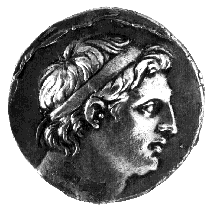



(51) Syria, Demetrios I Soter - AR tetradrachm, 155-154 B.C.,
16.24 g. (inv. 91.092).
Obverse: In laurel wreath, diademed head of Demetrios r.
Reverse:Tyche seated l., holding short scepter in r. and
cornucopia in l.; Nereid beside throne; monogram in l. field; ![]() (the date in the Seleukid Era = 155-154 B.C.) in
exergue;
(the date in the Seleukid Era = 155-154 B.C.) in
exergue; ![]()
: of King Demetrios
the Savior.
Provenance: Hesperia Art, 1959.
Bibliography: E.T. Newell, The Seleucid Mint at Antioch
(New York 1918) 34-46; G.K. Jenkins, "Notes on Seleucid Coins,"
Numismatic Chronicle 19 (1951) 2-5.
Demetrios I Soter, the son of King Seleukos IV, was given over as a hostage
to Rome in place of his uncle, who took the throne as Antiochos IV when
Seleukos died. But when Antiochos died and his child was put on the throne,
Demetrios escaped from Rome and in 162 B.C. returned to claim the Seleukid
throne. He set out to reconquer the Babylonian territory that had been lost
to the kingdom, thereby earning the title Soter or Saviour. In 150 B.C.
Demetrios was killed in battle against a coalition of neighboring states.
Demetrios' portrait on his early coins had appeared fairly realistic, but
toward the end of his reign he introduced this idealized type, retaining
something of the beaked nose of the earlier versions, but with the upward
gaze and the anastole and flowing hair alluding to portraits of Alexander.
The laurel wreath around the head refers to Apollo, the patron deity of
the Seleukid dynasty down to the reign of Demetrios' father (see no. 50).
The reference to Apollo is probably also meant to signal the return of legitimate
rule, since Antiochos IV had made Zeus Olympios his patron deity.
The figure on the reverse is Tyche or Fortune, a popular divinity of the
Hellenistic period and patron goddess of the Seleukid capital of Antioch,
where these coins were issued. She wears the turreted crown of the city
goddess.
K.J.B.



All contents copyright (c) 1996.
Lawrence University
All rights reserved.